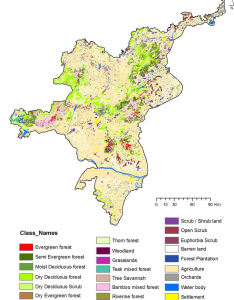In Tamil Nadu, Forest vegetation is divided into 3 major groups according to temperature zones namely Tropical Forests, Montane Subtropical Forests and Montane Temperate Forests, which are sub divided into nine type groups based on moisture and physiognomic variation. They are
| S.No | Major Forest Type group |
| 1 | Tropical wet evergreen |
| 2 | Tropical semi evergreen |
| 3 | Tropical moist deciduous |
| 4 | Littoral and swamp |
| 5 | Tropical dry deciduous |
| 6 | Tropical thorn |
| 7 | Tropical dry evergreen |
| 8 | Sub-Tropical Broad-leaved hill |
| 9 | Montane wet temperate |
- TROPICAL EVERGREEN FOREST
This type of forest is present on the western ghats of Tirunelveli, Kanyakumarai, The Nilgiris and Coimbatore districts on the upper slopes and top hills and sometimes on the steep slope of lower down. Tree species present in this area are Hopeaparvi flora, Artocarpus hirsuta, Syzygium cumini, Cinnamomum zeylanicum.
- TROPICAL SEMI EVERGREEN FOREST
This type occurs on slopes of hills and mountains usually up to 1000 m. Canopy are of two or three storeys. This forest type present in Coimbatore, Tirunelvei and Kanyakumari districts between western tropical evergreen and the moist deciduous type with mixture of occasional evergreen and abundant moist deciduous tree species. The species present in this type are Artocarpus hirsuta, Hopea parviflora, Lagerstroemia lanceolata, Terminalia paniculata
- TROPICAL MOIST DECIDUOUS FORESTS
This type of forest lies below the zone of semi evergreen and evergreen forests. The trees reach a height of 30 to 30 m and are deciduous. Bamboos are common. Bombax ceiba, Dillenia pentagyna, Mitragyna parviflora and Terminalia spp., are the common trees
- LITTORAL AND SWAMP FORESTS
This type of forest is present in the coastal area in the river deltas along the edges of the delta streams, tails of islands and over sea face where accreation is in progress. The vegetation, typically evergreen of moderate height, with leathery leaves, vivipary usually, composed of trees specially adapted to survive on tidal mud, permanenetly wet with salt water and submerged every tide. The species present are Rhizophor amucronata, R. apiculata, Avicennia officinalis, A. marina, Clerodendrum inereme, Acanthus ilicifolius etc. Stilt roots are very typical notable in Rhizophora spp
- TROPICAL DRY DECIDUOUS FORESTS
These forests are found at about 400 m and above. The canopy is closed. Most of the species are deciduous. The undergrowth is usually dense. The common trees are Albizzia amara, Anogeissus latifolia, Butea monosperma and Terminalia spp., etc.
- TROPICAL THORN FORESTS
Those forests are found from plains up to 400 m the common trees of top storey are Acacia ferruginea, Acacia leucophloea, Albizzia amara and Azadirachta indica
- TROPICAL DRY EVERGREEN FORESTS
A low forest consisting mostly of small coriaceous leaved evergreen trees with short boles and spreading crowns. The proportion of deciduous species may be large locally and climbers are numerous. The important species are Manilkara hexandra, Albizzia amara, Memecylon umbellatum, Atlantia monophylla and Pheonix sylvestris
- MONTANE SUBTROPICAL FORESTS
The semi-evergreen type of forest, present in the subtropical region of the state. In Eastern Ghats it is found in the upper slopes and Plateau of Shevaroys, Kollimalai, and Pachamalai. Epiphytes are common. The important species are Cedrella toona, Atrocarpus lakoocha, A.hirsuta, A.heterophyllus and Mangifera indica.
- MONTANE TEMPERATE FORESTS
The montane forest mostly confined to moist and sheltered valleys, glens and hollows as in the Anamalais, Nilgiri and Palani at above 1000 m. they are known in Tamil as ‘sholas’. The trees are evergreen and usually short boled. Ilex denticulate, I.wigtiana, Michelia nilagrica and Syzygium spp., are the common trees.
TNPSC Notes brings Prelims and Mains programs for TNPSC Prelims and TNPSC Mains Exam preparation. Various Programs initiated by TNPSC Notes are as follows:-
- TNPSC Mains Tests and Notes Program
- TNPSC Prelims Exam 2020- Test Series and Notes Program
- TNPSC Prelims and Mains Tests Series and Notes Program
- TNPSC Detailed Complete Prelims Notes
